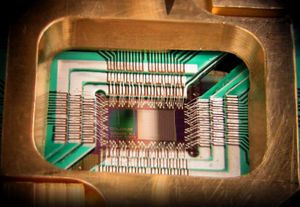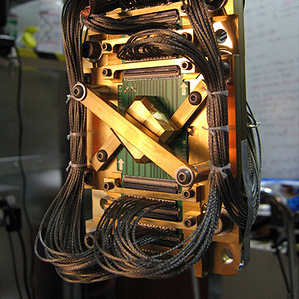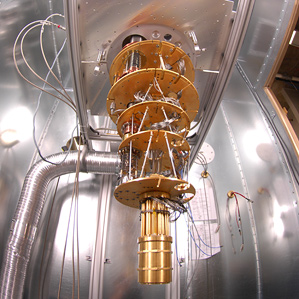أنظمة دي-ويڤ
 | |
| النوع | خاصة |
|---|---|
| الصناعة | أجهزة الحاسوب |
| تأسست | 1999 |
| المقر الرئيسي | برنانبي، كولومبيا البريطانية ، كندا |
الأشخاص الرئيسيون | ڤرن براونول، الرئيس التنفيذي گيوردي روز ڤ. پول لي، الرئيس |
| المنتجات | دي-ويڤ تو، اوريون وب سيرڤيس |
| الدخل | N/A |
| N/A | |
| الموظفون | approx. 60 |
| الشركات التابعة | لا يوجد |
| الموقع الإلكتروني | dwavesys.com |
أنظمة دي-ويڤ D-Wave Systems، هي شركة حاسوب كمومي، مقرها برنابي، كولومبيا البريطانية، كندا. في 11 مايو 2011، أعلنت دي-ويويڤ عن دي-ويڤ 1، المسمى "بأول حاسوب كمومي تجاري في العالم"، ويشار إليه أيضاً على أنه حاسوب كمومي adiabatic يستخدم quantum annealing to solve optimization problems operating on an 128 qubit chip-set.[1] في مايو 2013 أُعلن أن ناسا وگوگل أطلقا دي-ويڤ 2 512 كيوبيت.[2]
The D-Wave One was built on early prototypes such as D-Wave's Orion Quantum Computer. The prototype was a 16-qubit adiabatic quantum computer, demonstrated on February 13, 2007 at the Computer History Museum in Mountain View, California.[3] D-Wave demonstrated what they claimed to be a 28-qubit adiabatic quantum computer on November 12, 2007.[4] The chip was fabricated at NASA's Jet Propulsion Lab's microdevices lab in Pasadena, California.[5]
. . . . . . . . . . . . . . . . . . . . . . . . . . . . . . . . . . . . . . . . . . . . . . . . . . . . . . . . . . . . . . . . . . . . . . . . . . . . . . . . . . . . . . . . . . . . . . . . . . . . . . . . . . . . . . . . . . . . . . . . . . . . . . . . . . . . . . . . . . . . . . . . . . . . . . . . . . . . . . . . . . . . . . . .
الوصف التقني

As of June 2010, it has been published that a D-Wave processor comprises a programmable[6] superconducting integrated circuit with up to 128 pair-wise coupled[7] superconducting flux qubits.[8][9][10] The processor is designed to implement a special-purpose adiabatic quantum optimization algorithm[11][12] as opposed to being operated as a universal gate-model quantum computer.
D-Wave maintains a list of peer-reviewed technical publications on their website.[13]
التاريخ
D-Wave was founded by Haig Farris (former chair of board), Geordie Rose (CTO and former CEO), Bob Wiens (former CFO), and Alexandre Zagoskin (former VP Research and Chief Scientist). Farris taught an entrepreneurship course at UBC (University of British Columbia), where Rose obtained his Ph.D. and Zagoskin was a postdoctoral fellow. The company name refers to their first qubit designs, which used d-wave superconductors.
D-Wave operated as an offshoot from UBC[بحاجة لمصدر], while maintaining ties with the Department of Physics and Astronomy. It funded academic research in quantum computing, thus building a collaborative network of research scientists. The company collaborated with several universities and institutions, including UBC[بحاجة لمصدر], IPHT Jena[بحاجة لمصدر], Université de Sherbrooke[بحاجة لمصدر], University of Toronto[بحاجة لمصدر], University of Twente[بحاجة لمصدر], Chalmers University of Technology[بحاجة لمصدر], University of Erlangen[بحاجة لمصدر], and Jet Propulsion Laboratory[بحاجة لمصدر]. These researchers worked with D-Wave scientists and engineers. Some of D-Wave's peer-reviewed technical publications come from this period. Some publications have D-Wave employees as authors, while others include employees of their partners as well or only. As of 2005, these partnerships were no longer listed on D-Wave's website.[14][15]
D-Wave operated from various locations in Vancouver, Canada, and laboratory spaces at UBC before moving to its current location in the neighboring suburb of Burnaby[بحاجة لمصدر].
نموج اوريون
On February 13, 2007, D-Wave demonstrated the Orion system, running three different applications at the Computer History Museum in Mountain View, California. This marked the first public demonstration of, supposedly, a quantum computer and associated service.
The first application, an example of pattern matching, performed a search for a similar compound to a known drug within a database of molecules. The next application computed a seating arrangement for an event subject to compatibilities and incompatibilities between guests. The last involved solving a Sudoku puzzle.
The processors at the heart of D-Wave's "Orion quantum computing system" are hardware accelerators designed to solve a particular NP-complete problem related to the two dimensional Ising model in a magnetic field.[3] D-Wave terms the device a 16-qubit superconducting adiabatic quantum computer processor.[16][17]
According to the company, a conventional front end running an application that requires the solution of an NP-complete problem, such as pattern matching, passes the problem to the Orion system. However, the company does not make the claim its systems can solve NP-complete problems in polynomial time.
According to Dr. Geordie Rose, Founder and Chief Technology Officer of D-Wave, NP-complete problems "are probably not exactly solvable, no matter how big, fast or advanced computers get" so the adiabatic quantum computer used by the Orion system is intended to quickly compute an approximate solution.[18]
تجربة گوگل 2009
On Tuesday, December 8, 2009 at the Neural Information Processing Systems (NIPS) conference, a Google research team led by Hartmut Neven used D-Wave's processor to train a binary image classifier.
أنظمة حاسوب دي-ويڤ 1
On May 11, 2011, D-Wave Systems announced the D-Wave One, an integrated quantum computer system running on a 128 qubit processor. The processor used in the D-Wave One code-named "Rainier", performs a single mathematical operation named Discrete optimization. Rainier uses a process called quantum annealing to solve optimization problems. The D-Wave One is claimed to be the world's first commercially available quantum computer system.[19] The cost will be approximately $10,000,000.[20]
تعاون لوكهيد مارتين ودي-ويڤ
On May 25, 2011, Lockheed Martin signed a multi-year contract with D-Wave Systems to realize the benefits based upon a quantum annealing processor applied to some of Lockheed's most challenging computation problems. The contract also includes maintenance, associated professional services, and the purchase of the D-Wave One Quantum Computer System.[21]
Optimization problem solving in protein structure determination
In August 2012, a team of Harvard University researchers presented results of the largest protein folding problem solved to date using a quantum computer. The researchers solved instances of a lattice protein folding model, known as the Miyazawa-Jernigan model, on a D-Wave One quantum computer.[22][23]
أنظمة حاسبو دي-ويڤ 2
In early 2012, D-Wave Systems revealed a 512-qubit code named Vesuvius,[24] which it expected to launch before the end of 2012.[25]
In May 2013, Catherine McGeoch, a consultant D-Wave to made the first comparison of the technology against regular top-end desktop computers running an optimization algorithm. Using a configuration with 439 qubits, the system performed 3,600 times as fast as the best algorithm (CPLEX) on the conventional machine, solving problems with 100 or more variables in half a second compared with half an hour. However, she admitted that the comparison is "not quite fair, because generic computers will always perform less well than a device dedicated to solving a specific problem".[26] The results are presented at the Computing Frontiers 2013 conference.[27]
In March 2013, several groups of researchers at the Adiabatic Quantum Computing workshop at the Institute of Physics in London produced evidence of quantum entanglement in the D-Wave chips.[28]
In May 2013 it was announced that NASA and Google had jointly ordered a 512 qubit D-Wave Two that would be used for general research into applications.[2]
جدل
D-Wave was originally criticized by some scientists in the quantum computing field. However, on May 16 2013 NASA and Google, together with a consortium of universities, announced a partnership with D-Wave to investigate how D-Wave's computers could be used in the creation of artificial intelligence. Prior to announcing this partnership, NASA, Google, and Universities Space Research Association put a D-Wave computer through a series of benchmark and acceptance tests which it passed. Independent researchers found that D-Wave's computers can solve some problems as much as 3,600 times faster than digital computers.[29]
In 2007 Umesh Vazirani, a professor at UC Berkeley and one of the founders of quantum complexity theory, made the following criticism:[30]
Their claimed speedup over classical algorithms appears to be based on a misunderstanding of a paper my colleagues van Dam, Mosca and I wrote on "The power of adiabatic quantum computing." That speed up unfortunately does not hold in the setting at hand, and therefore D-Wave's "quantum computer" even if it turns out to be a true quantum computer, and even if it can be scaled to thousands of qubits, would likely not be more powerful than a cell phone.
Wim van Dam, a professor at UC Santa Barbara, summarized the scientific community consensus as of 2008 in the journal Nature Physics:[31]
At the moment it is impossible to say if D-Wave's quantum computer is intrinsically equivalent to a classical computer or not. So until more is known about their error rates, caveat emptor is the least one can say.
An article in the May 12, 2011 edition of Nature gives details which critical academics say proves that the company's chips do have some of the quantum mechanical properties needed for quantum computing.[32][33] Prior to the 2011 Nature paper, D-Wave was criticized for lacking proof that its computer was in fact a quantum computer. Nevertheless, questions remain due to the lack of conclusive experimental proof of quantum entanglement inside D-Wave devices.[34]
MIT professor Scott Aaronson, self-described "Chief D-Wave Skeptic", originally said that D-Wave's demonstrations did not prove anything about the workings of the computer. He said that a useful quantum computer would require a huge breakthrough in physics, which has not been published or shared with the physics community.[35] Aaronson has since updated his views on his blog, announcing that he was "retiring as Chief D-wave Skeptic" in 2011,[36] and reporting his "skeptical but positive" views based on a visit to D-Wave in February 2012.[34][37][38]
. . . . . . . . . . . . . . . . . . . . . . . . . . . . . . . . . . . . . . . . . . . . . . . . . . . . . . . . . . . . . . . . . . . . . . . . . . . . . . . . . . . . . . . . . . . . . . . . . . . . . . . . . . . . . . . . . . . . . . . . . . . . . . . . . . . . . . . . . . . . . . . . . . . . . . . . . . . . . . . . . . . . . . . .
مشاهير الخريجين والمتعاونين
وظفت دي-ويڤ أو تعاقدت مع العديد من أعضاء المجتمع العلمي بالإضافة إلى مختلف مستشاري الأعمال البارزين. ومنهم:
- أسپورو-گوزيك[39] (Harvard)
- دميتري ڤ. أڤرين (ستوني بروك)[بحاجة لمصدر]
- Seth Lloyd (MIT) [بحاجة لمصدر]
- ألكسندر زاگوسكين[40] (جامعة لوگبوروف)
انظر أيضاً
المصادر
- ^ Quantum annealing with manufactured spins(Nature)
- ^ أ ب Mansfield, Alex. "BBC News - Nasa buys into 'quantum' computer". Bbc.co.uk. Retrieved 2013-05-16.
- ^ أ ب "Quantum Computing Demo Announcement". 2007-01-19. Retrieved 2007-02-11.
- ^ D-Wave Systems: News
- ^ A picture of the demo chip « rose.blog
- ^ M. W. Johnson et al., "A scalable control system for a superconducting adiabatic quantum optimization processor," Supercond. Sci. Technol. 23, 065004 (2010); preprint available: arXiv:0907.3757
- ^ R. Harris et al., "Compound Josephson-junction coupler for flux qubits with minimal crosstalk," Phys. Rev. B 80, 052506 (2009); preprint available: arXiv:0904.3784
- ^ R. Harris et al., "Experimental demonstration of a robust and scalable flux qubit," Phys. Rev. B 81, 134510 (2010); preprint available: arXiv:0909.4321
- ^ Next Big Future: Robust and Scalable Flux Qubit, [1], September 23, 2009
- ^ Next Big Future: Dwave Systems Adiabatic Quantum Computer [2], October 23, 2009
- ^ Edward Farhi et al., "A Quantum Adiabatic Evolution Algorithm Applied to Random Instances of an NP-Complete Problem," Science 92, 5516, p.472 (2001)
- ^ Next Big Future: Dwave Publishes Experiments Consistents with Quantum Computing and Support Claim of At Least Quantum Annealing, [3], April 09, 2010
- ^ Publications
- ^ "D-Wave Systems at the Way Back Machine". 2002-11-23. Archived from the original on 2002-11-23. Retrieved 2007-02-17.
- ^ "D-Wave Systems at the Way Back Machine". 2005-03-24. Archived from the original on 2005-03-24. Retrieved 2007-02-17.
- ^ Kaminsky (2002-11-23). "Scalable Architecture for Adiabatic Quantum Computing of NP-Hard Problems". Quantum Computing & Quantum Bits in Mesoscopic Systems (Kluwer Academic (PDF). arXiv:quant-ph/0211152.
{{cite journal}}:|format=requires|url=(help); Unknown parameter|coauthors=ignored (|author=suggested) (help) - ^ Meglicki, Zdzislaw (2008). Quantum Computing Without Magic: Devices. MIT Press. pp. 390–391. ISBN 0-262-13506-X.
- ^ "Yeah but how fast is it? Part 3. OR some thoughts about adiabatic QC". 2006-08-27. Archived from the original on 2006-11-19. Retrieved 2007-02-11.
- ^ "Learning to program the D-Wave One". Retrieved 11 May 2011.
- ^ "First Ever Commercial Quantum Computer Now Available for $10 Million". Retrieved 25 May 2011.
- ^ "Lockheed Martin Signs Contract with D-Wave Systems".Retrieved 2011-05-25
- ^ D-Wave quantum computer solves protein folding problem : Nature News Blog
- ^ D-Wave uses quantum method to solve protein folding problem
- ^ D-Wave Defies World of Critics With 'First Quantum Cloud' | Wired Enterprise | Wired.com
- ^ The black box that could change the world - The Globe and Mail
- ^ Aron, Jacob (10 May 2013). "Commercial quantum computer leaves PC in the dust". New Scientist. Retrieved 14 May 2013.
- ^
McGeoch, Catherine; Wang, Cong. "Experimental Evaluation of an Adiabatic Quantum System for Combinatorial Optimization".
{{cite web}}: Unknown parameter|month=ignored (help) - ^ Aron, Jacob (8 March 2013). "Controversial quantum computer aces entanglement tests". New Scientist. Retrieved 14 May 2013.
- ^ Google and NASA Launch Quantum Computing AI Lab Technology Review By Charles Choi, May 16, 2013
- ^ "Shtetl-Optimized: D-Wave Easter Spectacular". 2007-04-07. Retrieved 2007-05-17.
- ^ "Quantum computing: In the 'death zone'?". 2007-04-07. Retrieved 2008-12-23.
- ^ Quantum annealing with manufactured spins Nature 473, 194–198, 12 May 2011
- ^ The CIA and Jeff Bezos Bet on Quantum Computing Technology Review October 4, 2012 by Tom Simonite
- ^ أ ب My visit to D-wave: Beyond the Roast Beef Sandwich 21 February 2012
- ^ "Shtetl-Optimized: The Orion Quantum Computer Anti-Hype FAQ". 2007-02-09. Retrieved 2007-05-17.
- ^ Quantum-Effect-Demonstrating Beef May 25 2011
- ^ "Shtetl-Optimized: Thanksgiving Special: D-Wave at MIT". 2007-11-22. Retrieved 2007-12-03.
- ^ "In Defence of D-Wave".
- ^ Our sponsors Aspuru-Guzik research group, Harvard University
- ^ "Department staff | Dr Alexandre Zagoskin | Physics | Loughborough University". Lboro.ac.uk. Retrieved 2013-05-16.
وصلات خارجية
- Official website
- Announcement of the 16-qubit quantum computer demonstration
- Google Tech Talks: Quantum Computing Day 2: Image Recognition with an Adiabatic Quantum Computer
- Theoretical performance of a D-Wave processor: Investigating the Performance of an Adiabatic Quantum Optimization Processor

